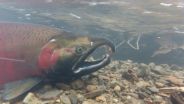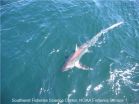(Press-News.org) Anticipated changes in climate will push West Coast marine species from sharks to salmon northward an average of 30 kilometers per decade, shaking up fish communities and shifting fishing grounds, according to a new study published in Progress in Oceanography.
The study suggests that shifting species will likely move into the habitats of other marine life to the north, especially in the Gulf of Alaska and Bering Sea. Some will simultaneously disappear from areas at the southern end of their ranges, especially off Oregon and California.
"As the climate warms, the species will follow the conditions they're adapted to," said Richard Brodeur, a NOAA Fisheries senior scientist at the Northwest Fisheries Science Center's Newport Research Station and coauthor of the study. "We're going to see more interactions between species and there will be winners and losers that we cannot foresee."
The study, led by William Cheung of the University of British Columbia, estimated changes in the distribution of 28 near-surface fish species commonly collected by research surveys in the northeast Pacific Ocean. The researchers used established global climate models to project how the distribution of the fish would shift by 2050 as greenhouse gases warm the atmosphere and, in turn, the ocean surface.
Brodeur cautioned that like any models, climate models carry uncertainty. While they provide a glimpse of the most likely changes in global climate, they may be less accurate when estimating more fine-scale, local changes.
"Nothing is certain," he said, "but we think we have a picture of the most likely changes."
Some species shifts are already being documented as West Coast waters are warming: predatory Humboldt squid from Central and South America have invaded the West Coast of North America in recent years, albacore have shifted to more northerly waters and eulachon have disappeared from warming waters at the southern end of their range.
"Thinking more broadly, this re-shuffling of marine species across the whole biological community may lead to declines in the beneficial functions of marine and coastal ecosystems," said Tom Okey, a Pew Fellow in Marine Conservation at the University of Victoria and a coauthor of the study. "These declines may occur much more rapidly and in more surprising ways than our expected changes in species alone."
The study anticipates warm-water species such as thresher sharks and chub mackerel becoming more prominent in the Gulf of Alaska and off British Columbia. Some predators such as sea lions and seabirds, which rear their young in fixed rookeries or colonies, may find the fish they usually prey on moving beyond predators' usual foraging ranges.
"If their prey moves farther north, they either have to travel farther and expend more energy to get to them, or find something else to eat," Brodeur said. "It's the same thing for fishermen. If it gets warmer, the fish they depend on are going to move up north and that means more travel time and more fuel will be needed to follow them, or else they may need to switch to different target species. It may not happen right away but we are likely to see that kind of a trend."
El Nino years, when tropical influences temporarily warm the eastern Pacific, offer a preview of what to expect as the climate warms.
Shifts in marine communities may be most pronounced in high-latitude regions such as the Gulf of Alaska and Bering Sea, which the study identifies as "hotspots" of change. Cold-water species such as salmon and capelin have narrower temperature preferences than warmer water species, making them more sensitive to ocean warming and likely to respond more quickly.
An intrusion of warm-water species into cooler areas could lead to significant changes in marine communities and ecosystems. The diversity of northern fish communities, now often dominated by a few very prolific species such as walleye pollock, may increase as southern species enter the region, leading to new food web and species interactions.
INFORMATION:
NOAA's mission is to understand and predict changes in the Earth's environment, from the depths of the ocean to the surface of the sun, and to conserve and manage our coastal and marine resources. Join us on Twitter, Facebook, Instagram and our other social media channels.
For the firefighters and rescue workers conducting the rescue and cleanup operations at Ground Zero from September 2001 to May 2002, exposure to hazardous airborne particles led to a disturbing "WTC cough" -- obstructed airways and inflammatory bronchial hyperactivity -- and acute inflammation of the lungs. At the time, bronchoscopy, the insertion of a fiber optic bronchoscope into the lung, was the only way to obtain lung samples. But this method is highly invasive and impractical for screening large populations.
That motivated Prof. Elizabeth Fireman of Tel Aviv University's ...
There are pros and cons to the support that victimized teenagers get from their friends. Depending on the type of aggression they are exposed to, such support may reduce youth's risk for depressive symptoms. On the other hand, it may make some young people follow the delinquent example of their friends, says a team of researchers from the University of Kansas in the US, led by John Cooley. Their findings are published in Springer's Journal of Psychopathology and Behavioral Assessment.
Adolescence is an important time during which youth establish their social identity. ...
Patients with heart disease who receive transfusions during surgeries do just as well with smaller amounts of blood and face no greater risk of dying from other diseases than patients who received more blood, according to a new Rutgers study.
The research, published in the journal Lancet, measures overall mortality and mortality from cardiovascular disease, cancer and severe infection, and offers new validation to a recent trend toward smaller transfusions.
For the study, led by Jeffrey Carson, chief of the Division of Internal Medicine at Rutgers Robert Wood Johnson ...
A class of drug for treating arthritis - all but shelved over fears about side effects - may be given a new lease of life, following the discovery of a possible way to identify which patients should avoid using it.
The new study, led by Imperial College London and published in the journal Circulation, sheds new light on the 10-year-old question of how COX-2 inhibitors - a type of non-steroidal anti-inflammatory drug (NSAID) - can increase the risk of heart attack in some people.
NSAIDs - which include very familiar drugs such as ibuprofen, diclofenac and aspirin - are ...
Typhoon Hagupit soaked the Philippines, and a NASA rainfall analysis indicated the storm dropped almost 19 inches in some areas. After Hagupit departed the Philippines as a tropical storm, NASA's Terra satellite passed over and captured a picture of the storm curled up like a cat waiting to pounce when it landfalls in Vietnam on Dec. 11.
The Tropical Rainfall Measuring Mission or TRMM satellite, managed by NASA and the Japan Aerospace Exploration Agency gathered over a week of rainfall data on Hagupit. That rainfall data along with data from other satellites was compiled ...
COLUMBIA, Mo. - Previous cancer research has revealed that women are less likely than men to suffer from non-sex specific cancers such as cancer of the colon, pancreas and stomach. Scientists theorized that perhaps this trend was due to a protecting effect created by female hormones, such as estrogen, that help prevent tumors from forming. Now, researchers at the University of Missouri have found evidence suggesting that the male hormone testosterone may actually be a contributing factor in the formation of colon cancer tumors.
In his study, James Amos-Landgraf, an assistant ...
Ants: Ever since agriculture evolved ca 10.000 years ago, plants have been artificially selected to become the fast growing and highly productive varieties we know today. However, humans were not the first to see merit in cultivating their own food, as ants have been doing this for 50 million years. A lineage of South-American ants collect leaves and recycle their own feces to manure a fungus garden for food. New research shows that these ants have an evolutionary history of improvement of their fungal crops.
A joint effort by researchers at the Universities of Copenhagen ...
ANN ARBOR, Mich. - Urinary tract infections can occur with no apparent cause, and as effectiveness of antibiotics fades, treating them is also becoming less predictable.
University of Michigan Medical School researchers have identified bacterial genes that help the infections spread, providing a potential new target for treating UTIs, a global public health concern mostly affecting women. UTIs lead to lost work time, emergency room visits and health care spending of $3.5 billion in the United States.
The research findings, published in this week's Proceedings of the ...
A new study by Robert Stahelin, an adjunct associate professor of chemistry and biochemistry at the University of Notre Dame and an associate professor at the Indiana University School of Medicine-South Bend, as well as a member of Notre Dame's Eck Institute for Global Health, investigates how the most abundant protein that composes the Ebola virus, VP 40, mediates replication of a new viral particle.
"In brief, the Ebola virus has just seven proteins that encode in its genome," Stahelin said. "VP40 is critical to the formation of a new viral particle and it does this ...
Ads can communicate their main message in as little as a tenth of a second, helped by color, according to a new study published in Marketing Science, a publication of the Institute for Operations Research and the Management Sciences (INFORMS).
The Buffer Effect: The Role of Color When Advertising Exposures Are Brief and Blurred is by Michel Wedel, Pepsico Chaired Professor of Marketing at the Robert H. Smith School of Business of the University of Maryland and Rik Pieters, Professor of Marketing at the Tilburg School of Economics and Management of the University of Tilburg ...



